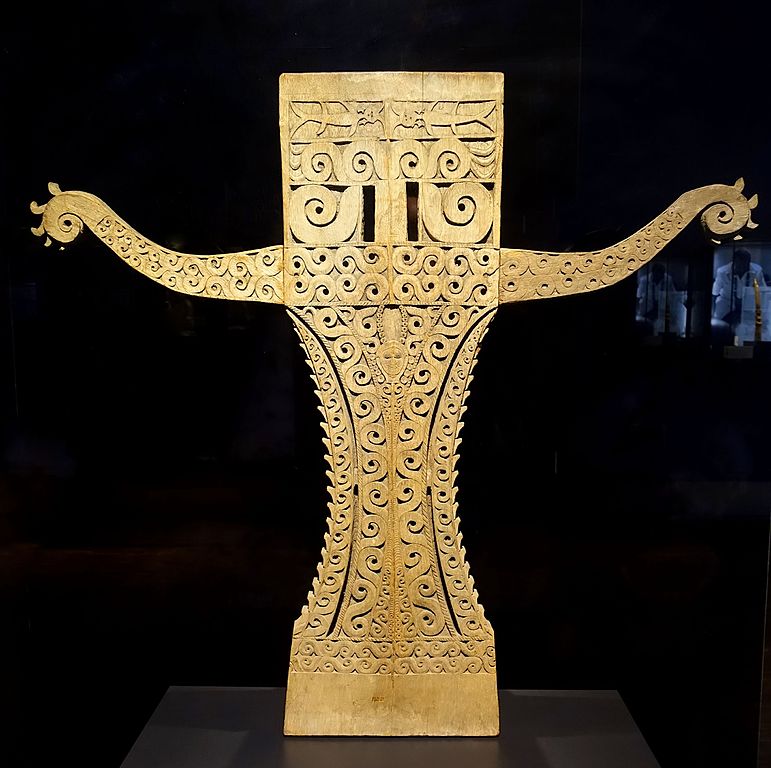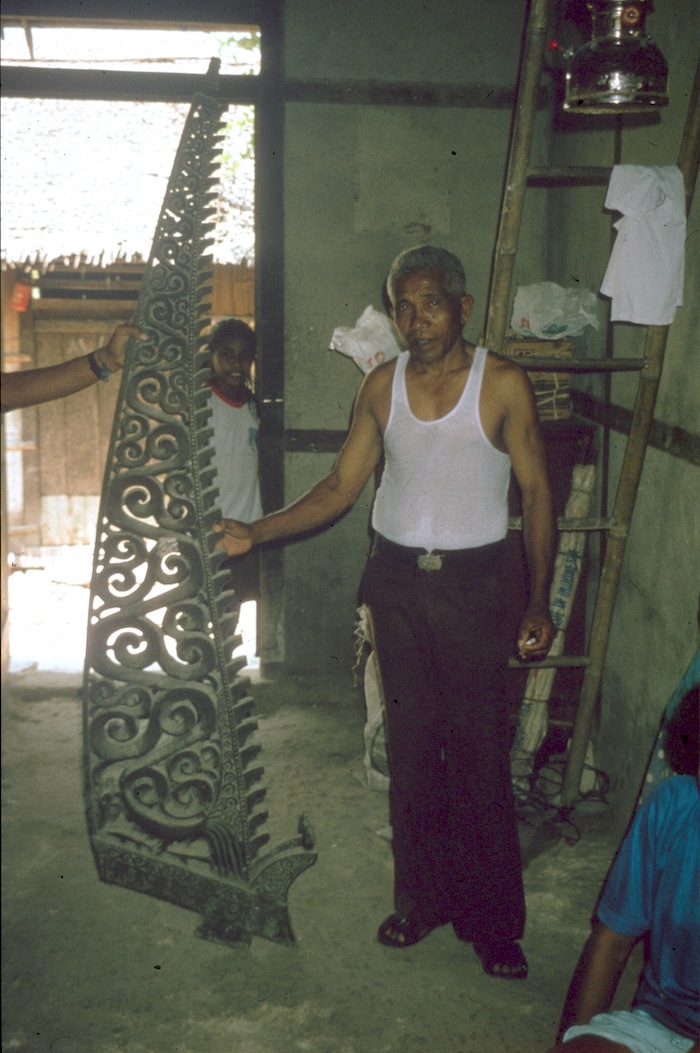To attempt to write the history of Tanimbarese art may not be an impossible task, however it difficult to see how it could be successfully accomplished. One of the main problems is the scarcity of material, both written documentation and actual artefacts. There are a number reasons for this scarcity. As noted above, in the colonial period contact with the Dutch was sparse, and thus the historical documentation available for those researching the history of the central Moluccas is simply not available for Tanimbar and the surrounding islands. Furthermore, the production of works related to an indigenous body of beliefs and conceptions ended in the 1920s, under the influence of the Christian missions, and the gradual shift towards Christian belief. There are few extant works from before this time partly due to the misguided fervour of the Protestant church, which was responsible for the burning of a large number of works.
The best source for the history of Tanimbarese art is Petrus Drabbe, however it is clear from his work that he had little feeling for the aesthetic or technical quality of the works about which he wrote:
Fine arts can scarcely be found in Tanimbar… one thing that could be classed as art is sculpture and the making of small statues. Most of these are in sitting posture. Of their forms it can be said that they are clumsy, and only infrequently do they possess distinctive contours. [Drabbe 1940 p.180. (Ch.13)]
The artistic skills of the Tanimbarese made more impact upon the English naturalist, Sir Henry Forbes, who visited the north of the archipelago at the end of the nineteenth century, but despite his enthusiasm, he gives little insight into the nature of earlier Tanimbarese art:
Of the intellectual characteristics of the Timor-Laut people I have formed no mean opinion. They are very clever carvers of wood and ivory; the “frameheads” of their prahus especially attract attention by the elegance of the devices and the excellence of the workmanship. The central pillars in houses are also elaborately carved. [Forbes 1884 p. 19]
The work of Drabbe, despite his clear lack of interest in and admiration for Tanimbarese carving, provides the best account available of its production and use, and he is informative on the social background to the art of Tanimbarese sculptors. From Drabbe it can be seen that the Tanimbarese would make sculptures as and when they needed them, and thus there was no monopoly or hereditary right to the trade of carving. However the high technical quality of many works still extant from the last century and, perhaps, even before this, suggests that there were individuals who specialised in the practice of sculpture when required to do so, and to whom the largest commissions would go. If a “history” is a rather too complex and daunting task, it would be helpful to consider a number of objects or classes of objects from the precolonial period in Tanimbar to attempt to apprehend at least some of the flavour of the work, and to suggest how they might have been conceived of or used.
 Image via Wikimedia Commons. Creative Commons.
Image via Wikimedia Commons. Creative Commons.
The first of these shall be the tavu (Fordatan language: the Yamdenan equivalent is lamngatabu although the Fordatan term is more widely used in Yamdena whilst speaking in Indonesian). The tavu is a large wooden construction that stood at the centre of certain “named” (that is, noble) houses where it acted as the main ritual centre of the house. The tavu can be seen as a representation of the unities at the centre of the house or house-complex (mata rumah). The panel represents the massed weight of the ancestors, rather than any particular ancestor, as the “root” or “base” of the noble house and of its offspring, the affiliated commoner (“unnamed”) houses. [McKinnon 1992 p.92] The tavu consisted of a carved panel which stood as if supporting the main roof beam of a house. On either side of the central panel were raised “arms” which were lifted up to join the roof beam.
A number of tavu still extant, and now in museum collections exhibit beautifully wrought spiral work carving which is a characteristic of earlier Tanimbarese art and occupy, to a greater or lesser extent, the central ground between pure abstraction and the relative realism of ancestor figurines (walut in Fordatan) which may have represented specific ancestors. These wooden figures would be placed above the tavu bound together in male-female pairs, and the tavu itself can be seen as a unity of opposites, of male and female. One example cited by McKinnon [1992 p.93] is of a work in the Museum voor Land-en-Volkenkunde in Rotterdam, which has symbols of the sun and the moon on its arms, symbols which were conceptualised in Tanimbar as male and female respectively. Others seem to tend more to maleness or to femaleness, portraying the appropriate genitalia, but in general these works are characterised by their bringing together of opposites. As a whole the tavu acted as what McKinnon calls, “an exquisitely elegant expression of a recomposed totality and synthetic unity,” which stood as the conceptual heart and underpinning of the house.
The prow boards (kora ulu: Fordatan) about which Forbes enthuses were also characterised by the spiral forms of the tavu, and are often depicted with figures of cockerels, fish and the odd little beasts McKinnon calls, “monsters with toothy mouths.” The cockerel is, or was, in Tanimbar, a metaphor for the strutting arrogance of the nobleman (mela in Fordatan) whose plumage is the amassed gold of his house. In the past, these nobles would fight duels, sparring not with weapons (although in other circumstances this undoubtedly happened) but with words. The two mela would exchange pantun (four line improvised poems) in an attempt to crush the opponent with overbearing wit and arrogance. This battle, although it would not result in death, was earnest, “hot”, and dangerous for the participants, recalling the “challenge and lightening fast motion of the cockfight.” [McKinnon 1988 p.158] If these are the associations of the cock in earlier Tanimbarese art, perhaps the fish that swim below the feet of many of the birds act as watery twins to their feathered companions. If they represent sharks, as I suspect they do, then they perhaps hold the same connotations of danger and challenge as does the cock. The kora ulu would generally be decorated with shells on the forward cutting edge of the board. I was told by the owner of the ten lur, a beautifully carved example of such a kora ulu, that these would have made a roaring sound as the prow board cut through the waves, although the mechanics of the matter remain obscure. Abraham Amelwatin, a sculptor based in Alusi Krawain, told me that in earlier times a cockerel would be placed at the front the boat to act as a compass, perhaps possessed of this curious ability because the cock crows as the sun rises in the east, and this he claimed accounted for the iconography of the cock on the prow board.
 Image © Will Buckingham, 1995
Image © Will Buckingham, 1995
One final and important class of sculpture that deserves consideration is the walut, or ancestor figure (occasionally called the Yamdenan equivalent of kukuwe.) There are a wide variety of these sculptures, and I am not sure how they would be classified, or whether indeed there were different classes of walut performing different functions. There are a number of examples in if Museum Nasional in Jakarta, in the Museum Siwalima in Ambon, and in the Tropenmuseun Amsterdam. Most of these figures are represented in squatting posture, as are their contemporary imitators, and in common with many such figures from throughout Southeast Asia. Yet still these works exhibit a wide range of forms and iconographies, and unlike the kora ulu and the tavu are characterised by a widely divergent levels of technical expertise, from the crude to the exquisitely carved. Here, skill in workmanship is of less importance than the power that resides in the sculpture, as shall be seen in the following section. The walut was, so it would seem, seen as the site of the power of the ancestors. Drabbe notes that hunters would take with them a small carving to ensure safety and success in the hunt [Drabbe 1940 p. 149 (Ch. 10)] and he notes that such carvings would be used for protection in other dangerous activities: for example the smelting of gold an the cutting of elephant tusks.
The “traditional” art of the Tanimbarese is varied both in style and in quality. The main distinguishing feature of much of it is the use of elaborate spiral motifs, and this is true to an extent for Tanimbarese cloth weaving too. Today these motifs rarely from a common part of the contemporary sculptor’s work, perhaps due to the complexity of the work involved. Carvings were produced for a wide range of reasons. Perhaps an impressive tavu or kora ulu would bring prestige on the house or the village, and add weight to their dealings in everyday life. However the carving of walut probably had less to do with prestige and more to do with expediency, and the harnessing of ancestral power to serve immediate ends. At present it is perhaps only possible to hint at the complexity of precolonial Tanimbarese art. A fuller history remains to be written.
< Previous Chapter || Next Chapter >